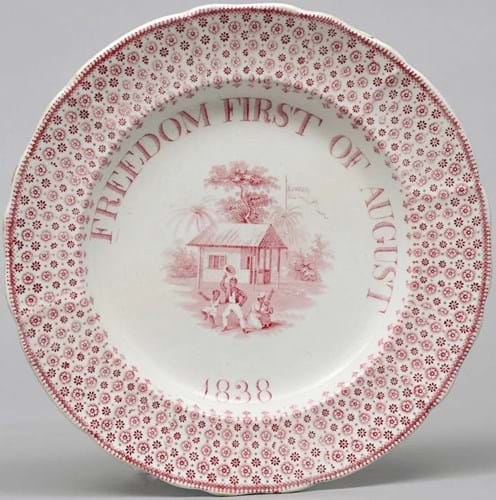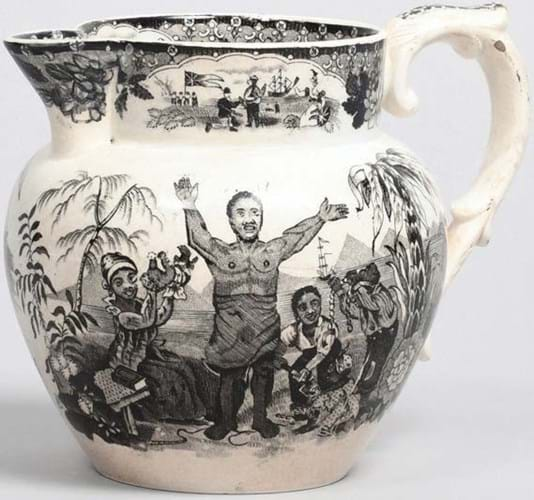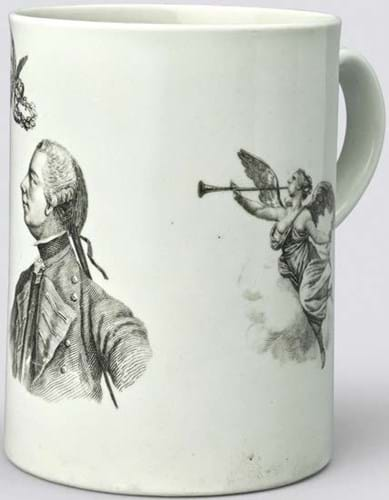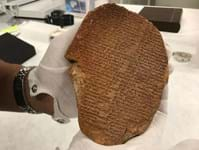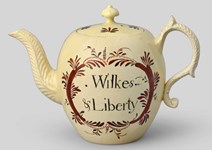The Prince of Wales’ marital problems, a sex scandal involving his brother the Duke of York, mass protests against government policies and a campaign for racial equality might remind you of recent headlines but it was the social history of Britain two centuries ago that was on offer at Woolley & Wallis (25% buyer’s premium) on September 8.
It was all there in the Robin Simpson collection of 530 frequently scurrilous, sometimes seditious 18th and 19th century commemorative ceramics offered on September 8.
Well-known for an encyclopaedic knowledge of British history, Simpson, who worked for the Department of Trade and Industry, was considered the leading collector in this field. Focusing on wares from the pre-Victorian periods, over 30 years he amassed a collection chronicling royal, social, political, war and maritime events from the reign of William and Mary to the 1838 coronation.
Simpson had hoped that the collection might remain intact in an institution but, after enquires led nowhere, he entered into discussions with Andrew Hilton of Historical & Collectable, known for regular specialist auctions of commemoratives, to handle the sale of the collection. He chose W&W as a partner for this sale.
Changed market
Led by the above-estimate £10,000 for the near-treasonous c.1766 Staffordshire teapot (illustrated in ATG No 2509) proclaiming the accession of Charles III, Jacobite king of Britain, the collection came to a changed market from when Simpson did most of his buying.
“Twenty years ago at auction you would see crowds of bidders jostling with each other to bid on commemoratives, but those days are over,” said Hilton, who has nearly 50 years of experience.
Another consideration was the fact that Simpson was happy to have rarities professionally restored and almost every lot bore evidence of this.
“Restored pieces can be expected to go for about a third of what perfect items would fetch,” Hilton added.
W&W expert Clare Durham, who handled the sale, also pointed out that Simpson’s death last year at the age of 80 not only brought his pieces to market but deprived that market of another of the dwindling group of well-heeled enthusiasts who kept prices up.
Nevertheless, nearly 90% of the lots sold to a mix of largely UK and US private buyers and the £330,000 hammer total was well above expectations.
“Some lots sold for below what Mr Simpson would have paid,” said Durham. “Others made considerably more, particularly the anti-slavery items. Most of these went to two major British museums and an American one. Museums have woken up to the importance of the anti-slavery campaign and are filling large gaps.”
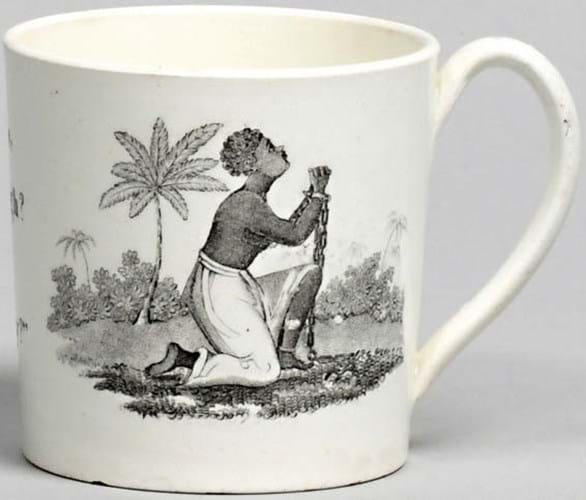
A c.1825 anti-slavery pearlware nursery mug – £2100 at Woolley & Wallis.
Estimated to fetch between £1250 and £1850, the seven pearlware and one earthenware item on that theme took a collective hammer total of £15,750. Among them was an example of Am I Not A Man and a Brother? – the Abolitionist phrase popularised by the 1787 Wedgwood medallion showing a kneeling slave holding up his chained arms and looking upwards.
Today it is controversial, showing, as it does, a submissive figure pleading to the world of white power. During the campaigning half century, however, the memorable message and arresting graphic was brilliant propaganda and used again and again over the years.
In Salisbury, a c.1830, 4½in (11.5cm) jug printed in black with a similar image and slogan made a quadruple-estimate £900.
A 2½in (6.5cm) tall mug, c.1825, featured a four-line poem asking (white) owners if God had told them to buy and sell their fellow men. Pitched at £150- 250, it took £2100.
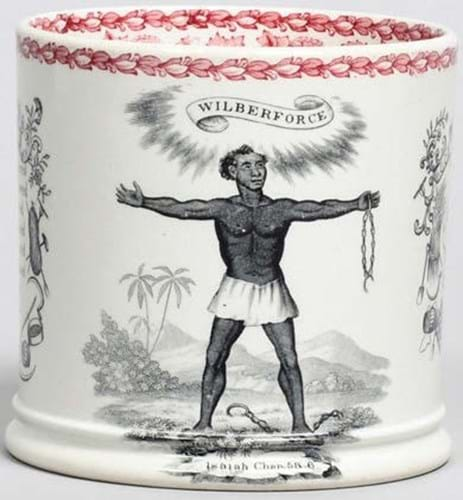
A c.1885 Wilberforce in-memoriam porter mug – £2800 at Woolley & Wallis.
Topping the section was an 1834, 5in (13cm) jug printed in black 1st August 1834: Abolition Of Slavery and depicting Africans celebrating in a tropical landscape. Estimated at £200-250, it took £3200.
The jug was printed Negro Emancipation August 1st 1834, but even today many Caribbeans mark 1838 (when a clause in the act keeping apprentices in slavery until their six-year indentures expired was repealed) as the true date of abolition.
A 10½in (27cm) earthenware dish printed in puce showed stereotypical young Africans celebrating beneath a flag inscribed Liberty and titled Freedom First of August 1838 went at 14-times estimate, taking £2800.
A curious piece was a 4½in (11cm) tall porter produced c.1885. Two sides were printed in black with God Speed The Plough and homilies about farming. The third showed a former slave throwing off his shackles with the name Wilberforce above and Isaiah 58:6 (…let the oppressed go free …break every yoke) below.
Catalogued as an in-memoriam item, it also took £2800, nearly 20 times the mid-estimate. As the great reformer Wilberforce died in 1833, the date of 1885 appears to have no particular relevance.
Staying neutral
Ceramics factories made whatever they believed people would buy. Rarely did they take sides.
During the American War of Independence and the War of 1812, items were produced catering to a British audience and for transatlantic export. Dated c.1780, halfway through the independence struggle, was a set of six 3¼in (8cm) oval portrait enamels of British Army and Navy heroes. Pitched at £1500-3000, they sold at £7800.
Best of seven such pieces in the Simpson collection glorying in American victories was a 5½in (14cm) Staffordshire creamware lustre jug printed in black with panels of two US defeats of Royal Navy ships in 1812. Signed in the print for Bentley, Wear and Bourne, it doubled the top estimate, going to a US buyer at £700.
A century-long parade of British military heroes mostly sold in three figures but two c.1760 Worcester black-printed half-length portrait mugs stood out.
Both celebrating the war against the French in Canada, one, 4¾in (12cm) tall, showing General James Wolfe flanked by representations of Mars and Fame, more than doubled top hopes at £4200.
Before Nelson’s glorious death at Trafalgar, Wolfe’s story was equally celebrated. The commander of the force that took Quebec from the French with a surprise attack on September 13, 1759, he was mortally wounded by three musket shots but survived long enough to learn of victory, one that was to lead to the collapse of French power in the New World.
The other mug was marked Admiral Boscawen’s victory at Louisburg opening up the St Lawrence before Wolfe’s triumph at Quebec. Depicting the admiral holding a map of Cape Breton with his family’s arms to the reverse, the 3½in (8.5cm) mug sold at a triple-estimate £3000.
Array of monarchs
Monarchs from William and Mary to William IV featured on various delft, pearlware and creamware pieces. As a general rule the earlier pieces brought most interest.
A c.1690, 13in (33cm) delft blue dash charger depicting the familiar full-length blue, yellow and manganese naive portraits of the couple doubled top estimate in selling at £8000 and an 8½in (22cm), c.1760, plate of George III in profile doubled lower hopes at £5000.
Royal respectability always had its admirers but, as today, scandal sold. George III’s sons supplied ample fodder. Prince Frederick, Duke of York had to resign for a while as commander-in-chief of the army in 1809 when it was discovered that his mistress, the fascinating Mary Anne Clark was, with his knowledge, selling officers’ commissions.
Best of four items at £1100 was a c.1809, creamware mug showing the duke signing the commission flanked by Ms Clarke and one Mary Anne Taylor, a witness at the parliamentary inquiry into the affair.
Frederick’s brother, both as Regent and King George IV, was a constant target of satirists, particularly regarding his later-divorced Queen Caroline, whom he loathed but the general public loved.
Top seller at a mid-estimate £1200 of those offered at W&W was a c.1820 (the year he became king), 5in (13cm) cylindrical creamware mug. A hand-coloured cartoon depicted George fleeing to the amusement of two observers, one saying there he goes a-sneaking…he’s afraid of meeting his wife.
Throughout the collection traditional conservative items were generally outsold by those celebrating radicals and rebels – originally aimed at the unenfranchised middle classes.
Political demonstrations for reform came to a head in 1819 at the Peterloo Massacre when yeomanry cavalry charged 60,000 protesters in Manchester, killing at least 11.
Newspapers, pamphleteers and a scathing poem by Shelley condemned the outrage, as too did the ever-alert pottery owners who producing hundreds of protest plates, mugs, teapots etc. Among those was a rare c.1819 Sunderland lustre jug, titled Retaliation Or Law Justly Administered On Nine Unjust Magistrates condemning the nine men who signed the order for the troops to go in.
Printed black and decorated in colours, the 6¾in (17.5cm) tall jug showed the scene of a butcher’s stall and, to the reverse, an enclosed cart carrying away the nine figures being excoriated by the crowd. It took a mid-estimate £1300.
Club purchase
Among the bidders on items calling for reform was London’s Reform Club. Now an august, non-partisan institution, its founders were liberals and radicals.
Natural targets for the mantelshelves and cabinets in Pall Mall included a rare Bristol pearlware jug attributed to William Fifield. Brightly painted with two men brawling and two raising a toast to reform, the 6¾in (17cm) tall baluster vase with cracked handle went above estimate at £1800.
A little violence in a good cause was wholly acceptable back then and sometimes outright criminality was encouraged. Customs tariffs to pay for wars were deeply unpopular as evidenced in a rare c.1787, 6in (15cm) baluster pearlware jug. Polychromed with a figure on horseback leading another horse laden with barrels it bore the slogan in black Success to the Smugler (sic). It tripled the lower estimate at £1500.



